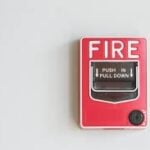Fire codes and state regulations can be a conundrum of information that’s confusing for even the most experienced of building professionals. Although abiding by these regulations may seem daunting, they are necessities to ensuring that your building is operating safely. There are specific regulations that when implemented can mean the difference between utter disaster and a fixable solution. Let’s review some of the basic information that may make compliance a bit easier.
Necessary Alarms
The city of San Diego Fire Code places a high emphasis on carbon monoxide protection. When a possible fire or carbon monoxide onset is detected, it’s important to have a reliable alarm that can alert those inside what’s going on. This will prevent unnecessary injury, smoke inhalation or exposure to harmful chemicals.
Buildings within the state of California are required to have active carbon monoxide alarms in facilities that contain garages, gas appliances, fireplaces, or units requiring the use of gas. They are required to be installed in every area of the home including basements and attics. There are specific alarms and detectors approved by the California state fire marshal. A comprehensive list can be found here.
In addition, The City of San Diego Fire Code state municipal requires a proof of installation of smoke, fire, and gas alarm systems. This application includes the date of installation, city and business certificates, as well as a state license containing the alarm system. The city must approve this permit in order to abide by code regulations.
Clear and Walkable Corridors
Certain entrances and walkways must be left clear in order to comply with the City of San Diego fire code and regulations. In addition, buildings that have an approved storage agreement signed by the Fire Marshal and Development Services Department must abide by the approved storage corridor agreement in order to store certain materials in walkways. This is all determined by the unit and class of combustible appliances used. Non-combustible materials, however, must be stored away from any entrances or exits to avoid blockage.
There are specific size regulations associated with flammable units as they cannot be larger than the entrance or exit corridor. In addition, these hallways should be clear of any work material, corded equipment, or hazardous materials unless approved by the Fire Marshal.
Fire Extinguishers
Portable fire extinguishers are required in every commercial building. They are also reliable sources for fire prevention, as they can allow you to stop the spread of a fire before it becomes a big deal. It should be installed securely into the wall and in compliance with the manufacturer’s instructions. In addition, fire sprinklers should be installed in the rare case that a fire occurs so as to lessen the severity of a possible fire.
Identification Signs
Every area that contains hazardous or combustible materials should be labeled. This avoids any possible threat of explosion or in-house fire. Each sign should include the class, hazardous ingredients, and reactivity listed. This should also showcase the category of hazardous material so as to understand its power. When keeping hazardous materials in storage, keep a detailed inventory of the items easily accessible.
Fire Entrance Availability
In order for fire and EMT professionals to enter your facility adequately, there are official protocols that need to be used to ensure that the rescue department has safe and easy access. The building should have access roadways with no blockage within 150-200 feet of the building. Each access road should be adequately labeled with NO PARKING FIRE LANE in a clear and easily readable manner.
Abiding by fire code regulations not only ensures the safety of your business but also your employees and customers. It is imperative that you overview the logistics of the California fire code basics in order to ensure your compliance, and consider speaking with a fire code consultant to ensure your business is following the San Diego fire code to the letter.











